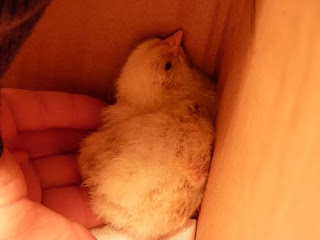In January, we decided to expand our flock - literally. We picked out 7 eggs and set them up in our new little incubator. We started with 3 brown, 2 white and one green, but due to a mis-assembled turning disk, we cracked a couple. The final assortment was 4 brown and 2 white which actually suited us well since we like the Rhode Island Red chickens the best and wanted to have more of them. We like the idea of this small incubator because we really don't want to get in over our heads and hatching more than 7 birds at once could get us there!

Approximately 21 days later, we heard cheeping in my husband's office. We kept the incubator in there because it's the warmest room in our house (small room, many computers). The first bird born on Valentine's Day was one of the white ones. We named her Una.
We ended up with 5 new chickens. One died in the shell (not strong enough to get themselves out) and one drowned in the water dish in the brooder the first night after being born. We were worried about that, so next time, we'll create some type of 'staging area' for the birds to rest after the ordeal of hatching. They are just exhausted after birth, but our incubator isn't really big enough for them to rest in it. Clearly the brooder (amongst other already hatched and rested chicks) is too dangerous.
Anyway, they are all doing very well. It was warm and sunny today, so we took them out for a little exploration time and they seemed to really enjoy it.
We are trying to be sure to handle these birds more often so that they are friendlier to humans than our current birds. We also find it funny that the 4 brown eggs from Rhode Island Red mom birds are all yellow chicks (normally, Rhode Island Red chicks are brown). I guess the White Leghorn rooster is more dominant in terms of coloring? We can tell them from the one 'pure blood' White Leghorn chick because they all have small black spots on their backs. Odd. We are both really curious as to how they'll look once they get their adult feathers.
 Clear view of one of the chick's little black spots identifying it as having a Rhode Island Red mother.
Clear view of one of the chick's little black spots identifying it as having a Rhode Island Red mother.Anyway, it's fun to have babies on the farm again!




No comments:
Post a Comment